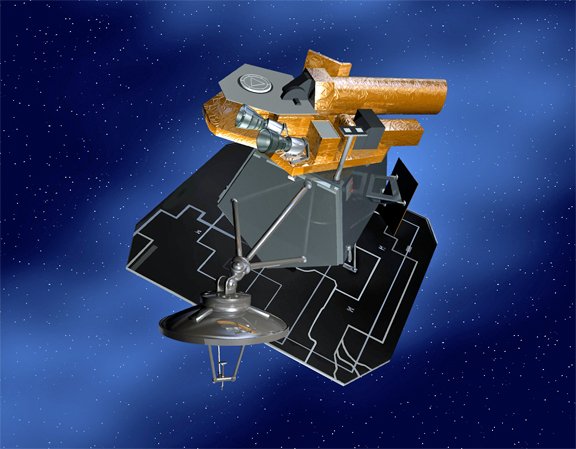
Artistic rendition of the Deep Impact spacecraft. Image Credit: NASA/JPL-Caltech.
The last communication with the spacecraft was on August 8th, 2013. Deep Impact mission controllers will continue to uplink commands in an attempt to reestablish communications with the spacecraft.
Mission controllers postulate that there was an anomaly generated by the spacecraft's software, which left the vehicle's computers in a condition where they are continuously rebooting themselves. If this is the case, the computers would not continue to command the vehicle's thrusters to fire and hold attitude. Lack of attitude hold makes attempts to reestablish communications more difficult because the orientation of the spacecraft's antennas is unknown. It also brings into question the vehicle's electrical power status, as the spacecraft derives its power from a solar array that is fixed, with its cells pointing in one direction.
Deep Impact is history's most traveled deep-space comet hunter. It successfully completed its original mission and a subsequent extended mission.
Launched in January 2005, the spacecraft traveled about 268 million miles (431 million kilometers) to the vicinity of comet Tempel 1. On July 3, 2005, the spacecraft deployed an impactor, which was essentially "run over" by the nucleus of Tempel 1 on July 4. Sixteen days after the comet encounter, the Deep Impact team placed the spacecraft on a trajectory to fly past Earth in late December 2007. The extended mission of the Deep Impact spacecraft culminated in the successful flyby of comet Hartley 2 on Nov. 4, 2010. In January of 2012, the spacecraft performed, from a distance, an imaging campaign of comet C/2009 P1 (Garradd), and in 2013, an imaging campaign of comet ISON.
To date, Deep Impact has traveled about 4.7 billion miles (7.58 billion kilometers) in space.
JPL, a division of the California Institute of Technology in Pasadena, manages the Deep Impact mission for NASA's Science Mission Directorate, Washington. The mission is part of the Discovery Program managed at NASA's Marshall Space Flight Center in Huntsville, Alabama. The spacecraft was built for NASA by Ball Aerospace & Technologies Corp., Boulder, Colorado.

